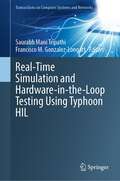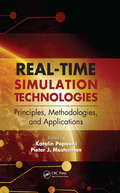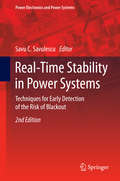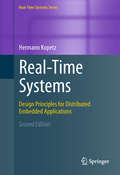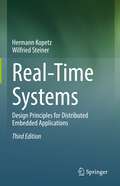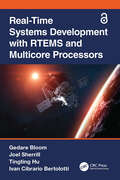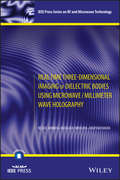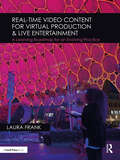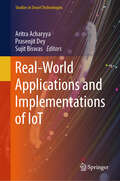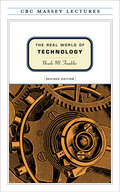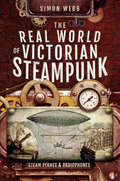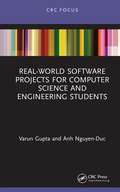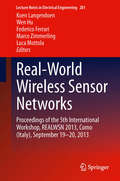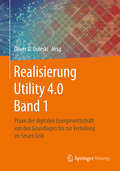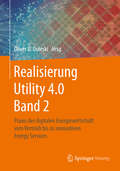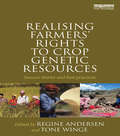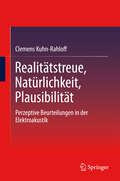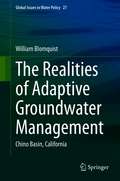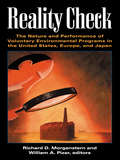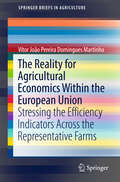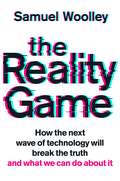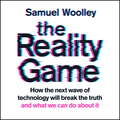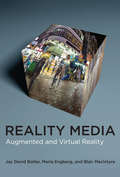- Table View
- List View
Real-Time Simulation and Hardware-in-the-Loop Testing Using Typhoon HIL (Transactions on Computer Systems and Networks)
by Saurabh Mani Tripathi Francisco M. Gonzalez-LongattThis book is an edited collection that explores the fundamental concepts of real-time simulation/hardware-in-the-loop testing using ‘Typhoon HIL’ for complex electrical systems. Typhoon HIL has recently emerged as a powerful tool in the rapidly growing field of ultra-high-fidelity controller-hardware-in-the-loop (C-HIL) simulations for power electronics, microgrids, and distribution networks. The book integrates the coverage of underlying theory and acclaimed methodological approaches and high-value applications of real-time simulation and hardware-in-the-loop testing—all from the perspectives of eminent researchers around the globe utilizing Typhoon HIL. This book serves as a valuable resource for engineers, academicians, researchers, experienced professionals, and research scholars engaged in /becoming familiarized with the real-time simulation of complex electrical systems using Typhoon HIL with a specific focus on hardware-in-the-loop testing.
Real-Time Simulation Technologies: Principles, Methodologies, And Applications (Computational Analysis, Synthesis, and Design of Dynamic Systems #13)
by Katalin Popovici Pieter J. MostermanReal-Time Simulation Technologies: Principles, Methodologies, and Applications is an edited compilation of work that explores fundamental concepts and basic techniques of real-time simulation for complex and diverse systems across a broad spectrum. Useful for both new entrants and experienced experts in the field, this book integrates coverage of detailed theory, acclaimed methodological approaches, entrenched technologies, and high-value applications of real-time simulation—all from the unique perspectives of renowned international contributors. Because it offers an accurate and otherwise unattainable assessment of how a system will behave over a particular time frame, real-time simulation is increasingly critical to the optimization of dynamic processes and adaptive systems in a variety of enterprises. These range in scope from the maintenance of the national power grid, to space exploration, to the development of virtual reality programs and cyber-physical systems. This book outlines how, for these and other undertakings, engineers must assimilate real-time data with computational tools for rapid decision making under uncertainty. Clarifying the central concepts behind real-time simulation tools and techniques, this one-of-a-kind resource: Discusses the state of the art, important challenges, and high-impact developments in simulation technologies Provides a basis for the study of real-time simulation as a fundamental and foundational technology Helps readers develop and refine principles that are applicable across a wide variety of application domains As science moves toward more advanced technologies, unconventional design approaches, and unproven regions of the design space, simulation tools are increasingly critical to successful design and operation of technical systems in a growing number of application domains. This must-have resource presents detailed coverage of real-time simulation for system design, parallel and distributed simulations, industry tools, and a large set of applications.
Real-Time Stability in Power Systems
by Savu C. SavulescuThis pioneering volume has been updated and enriched to reflect the state-of-the-art in blackout prediction and prevention. It documents and explains background and algorithmic aspects of the most successful steady-state, transient and voltage stability solutions available today in real-time. It also describes new, cutting-edge stability applications of synchrophasor technology, and captures industry acceptance of metrics and visualization tools that quantify and monitor the distance to instability. Expert contributors review a broad spectrum of additionally available techniques, such as trajectory sensitivities, ensuring this volume remains the definitive resource for industry practitioners and academic researchers in this critical area of power system operations.
Real-Time Structural Health Monitoring of Vibrating Systems
by Basuraj Bhowmik Budhaditya Hazra Vikram PakrashiTargeted at researchers and practitioners in the field of science and engineering, the book provides an introduction to real time structural health monitoring. Most work to date is based on algorithms that require windowing of the accumulated data, this work presents a coherent transition from the traditional batch mode practice to a recently developed array of recursive approaches. The book mainly focuses on the theoretical development and engineering applications of algorithms that are based on first order perturbation (FOP) techniques. The development of real time algorithms aimed at identifying the structural systems and the inflicted damage, online, through theoretical approaches paves the way for an in-depth understanding of the discussed topics. It then continues to demonstrate the solution to a class of inverse dynamic problems through numerically simulated systems. Extensive theoretical derivations supported by mathematical formulations, pivoted around the simple concepts of eigenspace updates, forms the key cornerstone of the book. The output response streaming in real time from multi degree of freedom systems provide key information about the system’s health that is subsequently utilized to identify the modal parameters and the damage, in real time. Damage indicators connotative of the nature, instant and location of damage, identified in a single framework are developed in the light of real time damage case studies. Backed by a comprehensive assortment of experimental test-beds, this book includes demonstrations to emulate real life damage scenarios under controlled laboratory conditions. Applicability of the proposed recursive methods towards practical problems demonstrate their robustness as viable candidates for real time structural health monitoring.
Real-Time Systems
by Hermann Kopetz"This book is a comprehensive text for the design of safety critical, hard real-time embedded systems. It offers a splendid example for the balanced, integrated treatment of systems and software engineering, helping readers tackle the hardest problems of advanced real-time system design, such as determinism, compositionality, timing and fault management. This book is an essential reading for advanced undergraduates and graduate students in a wide range of disciplines impacted by embedded computing and software. Its conceptual clarity, the style of explanations and the examples make the abstract concepts accessible for a wide audience." Janos Sztipanovits, Director E. Bronson Ingram Distinguished Professor of Engineering Institute for Software Integrated Systems Vanderbilt University Real-Time Systems focuses on hard real-time systems, which are computing systems that must meet their temporal specification in all anticipated load and fault scenarios. The book stresses the system aspects of distributed real-time applications, treating the issues of real-time, distribution and fault-tolerance from an integral point of view. A unique cross-fertilization of ideas and concepts between the academic and industrial worlds has led to the inclusion of many insightful examples from industry to explain the fundamental scientific concepts in a real-world setting. Compared to the first edition, new developments in complexity management, energy and power management, dependability, security, and the internet of things, are addressed. The book is written as a standard textbook for a high-level undergraduate or graduate course on real-time embedded systems or cyber-physical systems. Its practical approach to solving real-time problems, along with numerous summary exercises, makes it an excellent choice for researchers and practitioners alike.
Real-Time Systems: Design Principles for Distributed Embedded Applications
by Hermann Kopetz Wilfried Steiner"This book is a comprehensive text for the design of safety critical, hard real-time embedded systems. It offers a splendid example for the balanced, integrated treatment of systems and software engineering, helping readers tackle the hardest problems of advanced real-time system design, such as determinism, compositionality, timing and fault management. This book is an essential reading for advanced undergraduates and graduate students in a wide range of disciplines impacted by embedded computing and software. Its conceptual clarity, the style of explanations and the examples make the abstract concepts accessible for a wide audience."Janos Sztipanovits, DirectorE. Bronson Ingram Distinguished Professor of EngineeringInstitute for Software Integrated SystemsVanderbilt UniversityReal-Time Systems focuses on hard real-time systems, which are computing systems that must meet their temporal specification in all anticipated load and fault scenarios. The book stresses the system aspects of distributed real-time applications, treating the issues of real-time, distribution and fault-tolerance from an integral point of view. A unique cross-fertilization of ideas and concepts between the academic and industrial worlds has led to the inclusion of many insightful examples from industry to explain the fundamental scientific concepts in a real-world setting. Compared to the Second Edition, new developments in communication standards for time-sensitive networks, such as TSN and Time-Triggered Ethernet are addressed. Furthermore, this edition includes a new chapter on real-time aspects in cloud and fog computing.The book is written as a standard textbook for a high-level undergraduate or graduate course on real-time embedded systems or cyber-physical systems. Its practical approach to solving real-time problems, along with numerous summary exercises, makes it an excellent choice for researchers and practitioners alike.
Real-Time Systems Development with RTEMS and Multicore Processors (Embedded Systems)
by Gedare Bloom Joel Sherrill Tingting Hu Ivan Cibrario BertolottiThe proliferation of multicore processors in the embedded market for Internet-of-Things (IoT) and Cyber-Physical Systems (CPS) makes developing real-time embedded applications increasingly difficult. What is the underlying theory that makes multicore real-time possible? How does theory influence application design? When is a real-time operating system (RTOS) useful? What RTOS features do applications need? How does a mature RTOS help manage the complexity of multicore hardware?Real-Time Systems Development with RTEMS and Multicore Processors answers these questions and more with exemplar Real-Time Executive for Multiprocessor Systems (RTEMS) RTOS to provide concrete advice and examples for constructing useful, feature-rich applications. RTEMS is free, open-source software that supports multi-processor systems for over a dozen CPU architectures and over 150 specific system boards in applications spanning the range of IoT and CPS domains such as satellites, particle accelerators, robots, racing motorcycles, building controls, medical devices, and more.The focus of this book is on enabling real-time embedded software engineering while providing sufficient theoretical foundations and hardware background to understand the rationale for key decisions in RTOS and application design and implementation. The topics covered in this book include: Cross-compilation for embedded systems development Concurrent programming models used in real-time embedded software Real-time scheduling theory and algorithms used in wide practice Usage and comparison of two application programmer interfaces (APIs) in real-time embedded software: POSIX and the RTEMS Classic APIs Design and implementation in RTEMS of commonly found RTOS features for schedulers, task management, time-keeping, inter-task synchronization, inter-task communication, and networking The challenges introduced by multicore hardware, advances in multicore real-time theory, and software engineering multicore real-time systems with RTEMS All the authors of this book are experts in the academic field of real-time embedded systems. Two of the authors are primary open-source maintainers of the RTEMS software project.
Real-Time Three-Dimensional Imaging of Dielectric Bodies Using Microwave/Millimeter Wave Holography (IEEE Press Series on RF and Microwave Technology)
by Maryam Ravan Natalia Nikolova Reza AminehA guide to the applications of holographic techniques for microwave and millimeter wave imaging Real-Time Three-Dimensional Imaging of Dielectric Bodies Using Microwave/Millimeter Wave Holography offers an authoritative guide to the field of microwave holography for the specific application of imaging dielectric bodies. The authors—noted experts on the topic—review the early works in the area of optical and microwave holographic imaging and explore recent advances of the microwave and millimeter wave imaging techniques. These techniques are based on the measurement of both magnitude and phase over an aperture and then implementing digital image reconstruction. The book presents developments in the microwave holographic techniques for near-field imaging applications such as biomedical imaging and non-destructive testing of materials. The authors also examine novel holographic techniques to gain super-resolution or quantitative images. The book also includes a discussion of the capabilities and limitations of holographic reconstruction techniques and provides recommendations for overcoming many of the limitations. This important book: • Describes the evolution of wide-band microwave holography techniques from synthetic aperture radar principles • Explores two major approaches to near-field microwave holography: Using the incident field and Green's function information and using point-spread function of the imaging system • Introduces the "diffraction limit" in the resolution for techniques that are based on the Born approximation, and provides techniques to overcome this limit Written for students and research associates in microwave and millimeter wave engineering, Real-Time Three-Dimensional Imaging of Dielectric Bodies Using Microwave/Millimeter Wave Holography reviews microwave and millimeter-wave imaging techniques based on the holographic principles and provides information on the most current developments.
Real-Time Video Content for Virtual Production & Live Entertainment: A Learning Roadmap for an Evolving Practice
by Laura FrankReal-Time Video Content for Virtual Production & Live Entertainment looks at the evolution of current software and hardware, how these tools are used, and how to plan for productions dependent on real-time content. From rock concerts to theatre, live television broadcast to film production, art installations to immersive experiences, the book outlines the various applications of real-time video content – the intersection of gaming and performance that is revolutionizing how films are made and how video content is created for screens. Rather than render out a fixed video file, new tools allow for interactive video content that responds to audience activity, camera position, and performer action in real time. Combining software renderers with environmental information, video content is generated nearly instantaneously to simulate depth, creating a new world of Virtual Production. This book provides an overview of the current software and hardware used to create real-time content while also reviewing the various external technologies the real-time content is dependent upon. Case studies from industry experts appear in each chapter to reinforce the tools described, establish industry practice, and provide insight on a complex and rapidly growing discipline. Real-Time Video Content for Virtual Production & Live Entertainment prepares students and practitioners for a future working with real-time technologies and informs current entertainment technology professionals how to rethink about their old roles using these new tools. The book includes access to a companion website featuring web-based and video resources that expand on topics covered in the text. Each chapter has a unique page that points to example material, video presentations, and professional studies on chapter topics. You can visit the companion website at rtv-book.com.
Real-World Applications and Implementations of IoT (Studies in Smart Technologies)
by Aritra Acharyya Prasenjit Dey Sujit BiswasThis book explores state-of-the-art internet of things (IoT) solutions for energy conservation, security, agricultural advancements, mining security, healthcare, and environmental protection. This book delves deep into the technology, offering a comprehensive analysis, detailed descriptions, and in-depth discussions of recently developed IoT applications. With a strong focus on the cutting-edge research at a global scale, the book combines IoT with artificial intelligence (AI), shedding light on emerging possibilities and advancements. Designed to cater to a broad audience, from those with a foundational understanding of science to seasoned engineering and technology experts, this book can serve as an essential resource for engineering students and science master's programs. Researchers seeking to stay at the forefront of IoT and AI will also find it invaluable.
The Real World of Technology (The CBC Massey Lectures)
by Ursula FranklinIn this expanded edition of her bestselling 1989 CBC Massey Lectures, renowned scientist and humanitarian Ursula M. Franklin examines the impact of technology upon our lives and addresses the extraordinary changes since The Real World of Technology was first published. In four new chapters, Franklin tackles contentious issues, such as the dilution of privacy and intellectual property rights, the impact of the current technology on government and governance, the shift from consumer capitalism to investment capitalism, and the influence of the Internet upon the craft of writing.
The Real World of Victorian Steampunk: Steam Planes & Radiophones
by Simon WebbA look at the surprising nineteenth-century technology that inspires this literary and cultural movement: &“I was very impressed by this book.&” —SF Crowsnest In recent decades, steampunk has grown from a rather obscure subgenre of science fiction into a striking and distinctive style of fashion, art, design, and even music. It is in the written word, however, that steampunk has its roots—and in this book Simon Webb explores and examines the real inventions that underpin the fantasy. In doing so, he reveals a world unknown to most people today. Webb reveals the Victorian era as a surprising place: one of steam-powered airplanes, fax machines linking Moscow and St Petersburg, steam cars traveling at over 100 mph, electric taxis, and wireless telephones. It is, in short, the nineteenth century as you&’ve never before seen it—a steampunk extravaganza of anachronistic technology and unfamiliar gadgets. Imagine Europe spanned by a mechanical internet, a telecommunication system of clattering semaphore towers capable of transmitting information across the continent in a matter of minutes. Consider too, the fact that a steam plane the size of a modern airliner took off in England in 1894. Drawing entirely on contemporary sources, we see how little-known developments in technology have been used as the basis for so many steampunk narratives. From seminal novels such as The Difference Engine to the steampunk fantasy of Terry Pratchett&’s later works, this book shows that steampunk is at least as much solid fact as it is whimsical fiction.
Real-World Software Projects for Computer Science and Engineering Students
by Varun Gupta Anh Nguyen-DucDeveloping projects outside of a classroom setting can be intimidating for students and is not always a seamless process. Real-World Software Projects for Computer Science and Engineering Students is a quick, easy source for tackling such issues. Filling a critical gap in the research literature, the book: Is ideal for academic project supervisors. Helps researchers conduct interdisciplinary research. Guides computer science students on undertaking and implementing research-based projects This book explains how to develop highly complex, industry-specific projects touching on real-world complexities of software developments. It shows how to develop projects for students who have not yet had the chance to gain real-world experience, providing opportunity to become familiar with the skills needed to implement projects using standard development methodologies. The book is also a great source for teachers of undergraduate students in software engineering and computer science as it can help students prepare for the risk and uncertainty that is typical of software development in industrial settings.
Real-World Wireless Sensor Networks
by Koen Langendoen Wen Hu Federico Ferrari Marco Zimmerling Luca MottolaThis edited book presents the results of the 5th Workshop on Real-world Wireless Sensor Networks (REALWSN). The purpose of this workshop was to bring together researchers and practitioners working in the area of sensor networks, with focus on real-world experiments or deployments of wireless sensor networks. Included were, nonetheless, emerging forms of sensing such as those that leverage smart phones, Internet of Things, RFIDs, and robots. Indeed, when working with real-world experiments or deployments, many new or unforeseen issues may arise: the network environment may be composed of a variety of different technologies, leading to very heterogeneous network structures; software development for large scale networks poses new types of problems; the performance of prototype networks may differ significantly from the deployed system; whereas actual sensor network deployments may need a complex combination of autonomous and manual configuration. Furthermore, results obtained through simulation are typically not directly applicable to operational networks; it is therefore imperative for the community to produce results from experimental research. The workshop collected the state of the art in emerging and current research trends dealing with Real-world Wireless Sensor Networks, with the aim of representing a stepping stone for future research in this field.
Realisierung Utility 4.0 Band 1: Praxis der digitalen Energiewirtschaft von den Grundlagen bis zur Verteilung im Smart Grid
by Oliver D. DoleskiBei der Digitalisierung des Energiesektors von Praxiserfahrungen anderer Experten profitieren! Dieser bewährten Devise folgend zeigen Autoren aus Versorgungs- und IT-Unternehmen, Beratungen und Start-ups ausgewählte Lösungen für eine erfolgreiche digitale Transformation der Energiebranche. Durch die Lektüre der ersten zweibändigen Fachpublikation zur Digitalisierung der Energiewirtschaft im deutschsprachigen Raum kann der Leser von Expertenwissen profitieren und seinen Nutzen aus realen Anwendungsfällen sowie der Beschreibung umgesetzter Geschäftsmodelle der digitalen Energiewelt ziehen.In Band 1 werden die wesentlichen Grundlagen des digitalen Business in der Energiewirtschaft präsentiert. Dem Einführungsteil folgen vier Abschnitte zu unterschiedlichen Facetten der Digitalisierung entlang der energiewirtschaftlichen Wertschöpfung von der Erzeugung bis zur Verteilung im Smart Grid.
Realisierung Utility 4.0 Band 2: Praxis der digitalen Energiewirtschaft vom Vertrieb bis zu innovativen Energy Services
by Oliver D. DoleskiBei der Digitalisierung des Energiesektors von Praxiserfahrungen anderer Experten profitieren! Dieser bewährten Devise folgend zeigen Autoren aus Versorgungs- und IT-Unternehmen, Beratungen und Start-ups ausgewählte Lösungen für eine erfolgreiche digitale Transformation der Energiebranche. Durch die Lektüre der ersten zweibändigen Fachpublikation zur Digitalisierung der Energiewirtschaft im deutschsprachigen Raum kann der Leser von Expertenwissen profitieren und seinen Nutzen aus realen Anwendungsfällen sowie der Beschreibung umgesetzter Geschäftsmodelle der digitalen Energiewelt ziehen. Band 2 führt die Gliederung entlang der energiewirtschaftlichen Wertschöpfung des ersten Bands fort. Das Spektrum reicht von den vertrieblichen Aspekten der digitalen Energiewelt bis hin zu Praxisbeiträgen zum Zusammenwachsen von Energie, Mobilität, Kommunikation und Stadtentwicklung.
Realising Farmers' Rights to Crop Genetic Resources: Success Stories and Best Practices
by Regine Andersen Tone WingeFarmers' Rights are essential for maintaining crop genetic diversity, which is the basis of all food and agricultural production in the world. The International Treaty on Plant Genetic Resources for Food and Agriculture recognizes Farmers' Rights and provides for relevant measures. However, implementation is slow, and in many countries there is resistance. This book shows the necessity of realizing Farmers' Rights for poverty alleviation and food security, the practical possibilities of doing so, and the potential gains for development and society at large. It provides decision-makers and practitioners with a conceptual framework for understanding Farmers’ Rights and success stories showing how each of the elements of Farmers' Rights can be realized in practice. The success stories have brought substantial achievements as regards one or more of the four elements of Farmers' Rights: the rights of farmers to save, use, exchange and sell farm-saved seed; the protection of traditional knowledge; benefit- sharing; and participation in decision-making. This does not mean that these examples are perfect. Challenges encountered on the way are conveyed and offer important lessons. The stories represent different regions and localities, including Europe, Asia, Africa and Latin America, as well as various categories of stakeholders and types of initiatives and policies.
The realistic empiricism of Mach, James, and Russell
by Erik C. BanksIn the early twentieth century, Ernst Mach, William James, and Bertrand Russell founded a philosophical and scientific movement known as 'neutral monism', based on the view that minds and physical objects are constructed out of elements or events which are neither mental nor physical, but neutral between the two. This movement offers a unified scientific outlook which includes sensations in human experience and events in the world of physics under one roof. In this book Erik C. Banks discusses this important movement as a whole for the first time. He explores the ways in which the three philosophers can be connected, and applies their ideas to contemporary problems in the philosophy of mind and the philosophy of science - in particular the relation of sensations to brain processes, and the problem of constructing extended bodies in space and time from particular events and causal relations.
Realitätstreue, Natürlichkeit, Plausibilität
by Clemens Kuhn-RahloffDieses Buch richtet sich an Ingenieure und Forscher im Bereich der Kommunikationsakustik und anderen Gebieten der Wahrnehmungsforschung. Es bewegt sich im interdisziplinären Feld von Kommunikationsakustik, Informationstheorie und Wahrnehmungspsychologie und liefert einen wesentlichen Beitrag zum Verständnis der akustischen Wahrnehmung. Im Zentrum steht dabei der Begriff der Plausibilität als grundlegender Bestandteil kommunikationsakustischer Technik. Um Eigenschaften von Plausibilitätsurteilen bei der akustischen Wahrnehmung zu von Menschen zu erörtern, stellt das Buch ausgewählte top-down-Prozesse der Wahrnehmung in den Vordergrund, die das Urteilsverhalten beeinflussen. Plausibilität wird im Kontext existierender Modelle für perzeptive Messungen dargestellt und die Anforderungen werden diskutiert, die an den Begriff gestellt werden, wenn er im psychoakustischen Sinn als Messgröße aufgefasst wird.
The Realities of Adaptive Groundwater Management: Chino Basin, California (Global Issues in Water Policy #27)
by William BlomquistThis book has three primary objectives. The first objective is to provide scholars with a more realistic view of adaptive management, without arguing against adaptive management. Adaptive management is necessary as well as desirable, but it is not easy, and demonstrating that through the Chino Basin experience is an important goal. The second objective is to provide practitioners with encouraging yet cautionary lessons about the challenges and benefits of an adaptive approach – in similar fashion as the first objective, the goal here is to endorse the adaptive approach but in a clear-eyed manner that clarifies how hard it is and how much it requires. A third objective is to show all audiences that resource governance systems can fail, change, and succeed. There is no such thing as an ideal institutional design that is guaranteed to work; rather, making institutional arrangements work entails learning and adjustment when they begin to show problems as they inevitably will.
Reality Check: The Nature and Performance of Voluntary Environmental Programs in the United States, Europe, and Japan
by Richard D. Morgenstern William A. PizerSince the early 1990s, voluntary programs have played an increasingly prominent role in environmental management in the U.S. and other industrialized countries. Programs have attempted to address problems ranging from climate change and energy efficiency, to more localized air and water pollution problems. But do they work? Despite a growing theoretical literature, there is limited empirical evidence on their success or the situations most conducive to the approaches. Even less is known about their cost-effectiveness. Getting credible answers is important. Research to date has been largely limited to individual programs. This innovative book seeks to clarify what is known by looking at a range of program types, including different approaches adopted in different nations. The focus is on assessing actual performance via seven case studies, including the U.S. Climate Wise program, the U.S. EPA's 33/50 program on toxic chemicals, the U.K. Climate Change Agreements, and the Keidanren Voluntary Action Plan in Japan. The central goals of Reality Check are understanding outcomes and, more specifically, the relationship between outcomes and design. By including in-depth analyses by experts from the U.S., Europe, and Japan, the book advances scholarship and provides practical information for the future design of voluntary programs to stakeholders and policymakers on all sides of the Atlantic and Pacific.
The Reality for Agricultural Economics Within the European Union: Stressing the Efficiency Indicators Across the Representative Farms (SpringerBriefs in Agriculture)
by Vítor João Pereira Domingues MartinhoThe objective of this study is to analyze several dimensions of the agricultural economics reality for the representative farms of the European Union countries by using microeconomic data available in the Farm Accountancy Data Network from 1989-2009. To support this research, several ratios and efficiency indicators were calculated across several variables relative, namely, to the agricultural output and the utilized agricultural area. These ratios and indicators were analyzed further through econometric models associated with the convergence approaches, presenting with more detail the Portuguese case. Furthermore, it is important to design a set of strategies that are more suited to the European Union realities.
The Reality Game: A gripping investigation into deepfake videos, the next wave of fake news and what it means for democracy
by Samuel WoolleyTHIS ISN'T AN EPISODE OF BLACK MIRROR. THIS. IS. THE. FUTURE. 'A mind-blowing and essential book for a future that's practically already here. This book scares the hell out of me, but if we listen to Woolley's wake-up call, then I also have hope.' Jane McGonigal, author of Reality is BrokenThe problem of online disinformation is only getting worse. Social media may well play a role in the US 2020 presidential election and other major political events. But that doesn't even begin to describe what future propaganda will look like. As Samuel Woolley shows, we will soon be navigating new technologies such as human-like automated voice systems, machine learning, 'deep-fake' AI-edited videos and images, interactive memes, virtual reality and augmented reality. In stories both deeply researched and compellingly written, Woolley describes this future, and explains how the technology can be manipulated, who might control it and its impact on political strategy. Finally, Woolley proposes strategic responses to this threat with the ultimate goal of empowering activists and pushing technology builders to design for democracy. We may not be able to alter how the internet was used to challenge democracy in years past but we can follow the signals to prevent manipulation in the future - and to use these powerful new tools not to control people but to empower them.
The Reality Game: A gripping investigation into deepfake videos, the next wave of fake news and what it means for democracy
by Samuel WoolleyThe problem of online disinformation is only getting worse. Social media may well play a role in the the US 2020 presidential election and other major political events. But that doesn't even begin to describe what future propaganda will look like. As Samuel Woolley shows, we will soon be navigating new technologies such as human-like automated voice systems, machine learning, 'deep-fake' AI-edited videos and images, interactive memes, virtual reality and augmented reality. In stories both deeply researched and compellingly written, Woolley describes this future, and explains how the technology can be manipulated, who might control it and its impact on political strategy. (p) 2020 Octopus Publishing GroupFinally, Woolley proposes strategic responses to this threat with the ultimate goal of empowering activists and pushing technology builders to design for democracy. We may not be able to alter how the internet was used to challenge democracy in years past but we can follow the signals to prevent manipulation in the future - and to use these powerful new tools not to control people but to empower them.
Reality Media: Augmented and Virtual Reality
by Jay David Bolter Maria Engberg Blair MacIntyreHow augmented reality and virtual reality are taking their places in contemporary media culture alongside film and television.TThis book positions augmented reality (AR) and virtual reality (VR) firmly in contemporary media culture. The authors view AR and VR not as the latest hyped technologies but as media—the latest in a series of what they term &“reality media,&” taking their places alongside film and television. Reality media inserts a layer of media between us and our perception of the world; AR and VR do not replace reality but refashion a reality for us. Each reality medium mediates and remediates; each offers a new representation that we implicitly compare to our experience of the world in itself but also through other media. The authors show that as forms of reality media emerge, they not only chart a future path for media culture, but also redefine media past. With AR and VR in mind, then, we can recognize their precursors in eighteenth-century panoramas and the Broadway lights of the 1930s. A digital version of Reality Media, available through the book&’s website, invites readers to visit a series of virtual rooms featuring interactivity, 3-D models, videos, images, and texts that explore the themes of the book.
